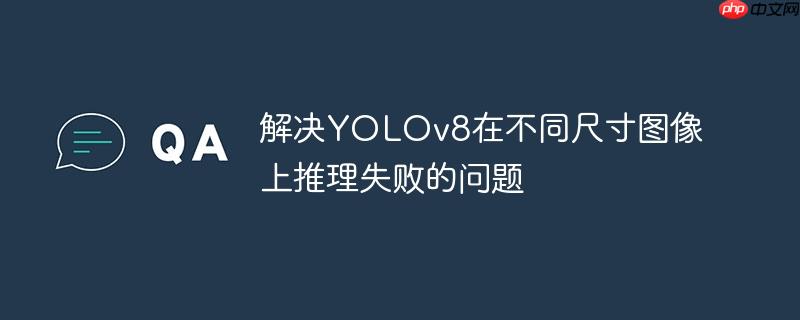
当使用yolov8这类卷积神经网络(cnn)进行目标检测时,一个常见且关键的问题是模型对输入图像尺寸的严格要求。许多用户在训练模型时使用特定尺寸(例如512x512像素)的图像,但在推理阶段尝试对尺寸显著不同(如2145x1195像素)的图像进行预测时,模型性能会急剧下降甚至完全失效。这并非模型本身的问题,而是由于神经网络的内部结构——特别是其卷积层和全连接层——是为处理特定尺寸的输入而设计的。
深度学习模型,尤其是基于卷积神经网络的模型,其内部的权重矩阵和特征图尺寸在训练阶段就已经固定。这意味着模型期望接收特定尺寸的输入数据。如果输入的图像尺寸与模型训练时或设计时所期望的尺寸不符,将导致:
因此,在将图像输入到YOLOv8模型进行推理之前,进行必要的图像预处理,特别是尺寸调整,是至关重要的一步。
解决方案的核心在于将待推理的图像调整到模型训练时所使用的相同尺寸。例如,如果模型在512x512的图像上训练,那么所有待推理的图像都应首先被缩放或裁剪到512x512。
以下是使用PyTorch和TensorFlow框架进行图像尺寸调整的示例代码:
在PyTorch生态系统中,torchvision.transforms模块提供了丰富的图像变换功能,包括尺寸调整。
import torchvision.transforms as transforms
from PIL import Image
import torch
def preprocess_image_pytorch(image_path: str, desired_size: tuple = (512, 512)) -> torch.Tensor:
"""
使用PyTorch的transforms对图像进行尺寸调整和预处理。
Args:
image_path (str): 图像文件的路径。
desired_size (tuple): 目标图像尺寸,例如 (高度, 宽度)。
Returns:
torch.Tensor: 经过尺寸调整和转换为Tensor的图像。
"""
try:
image = Image.open(image_path).convert("RGB") # 确保图像为RGB格式
except FileNotFoundError:
print(f"错误:文件未找到 - {image_path}")
return None
except Exception as e:
print(f"打开图像时发生错误:{e}")
return None
transform = transforms.Compose([
transforms.Resize(desired_size), # 调整图像尺寸
transforms.ToTensor(), # 将PIL图像转换为PyTorch Tensor
# 如果训练时进行了归一化,这里也需要添加
# transforms.Normalize(mean=[0.485, 0.456, 0.406], std=[0.229, 0.224, 0.225]),
])
resized_image_tensor = transform(image)
return resized_image_tensor
# 示例用法
image_path = "path/to/your/large_image.jpg"
# 假设YOLOv8模型是在512x512尺寸上训练的
model_input_size = (512, 512)
processed_image = preprocess_image_pytorch(image_path, model_input_size)
if processed_image is not None:
print(f"处理后的图像张量尺寸:{processed_image.shape}")
# 在这里使用YOLOv8模型进行推理
# model(processed_image.unsqueeze(0)) # 对于单个图像,通常需要增加一个批次维度在TensorFlow框架中,tf.image模块提供了强大的图像处理功能,包括图像尺寸调整。
import tensorflow as tf
from PIL import Image
import numpy as np
def preprocess_image_tensorflow(image_path: str, desired_size: tuple = (512, 512)) -> tf.Tensor:
"""
使用TensorFlow对图像进行尺寸调整和预处理。
Args:
image_path (str): 图像文件的路径。
desired_size (tuple): 目标图像尺寸,例如 (高度, 宽度)。
Returns:
tf.Tensor: 经过尺寸调整和转换为TensorFlow Tensor的图像。
"""
try:
# 使用PIL加载图像,然后转换为NumPy数组
image_pil = Image.open(image_path).convert("RGB")
image_np = np.array(image_pil)
except FileNotFoundError:
print(f"错误:文件未找到 - {image_path}")
return None
except Exception as e:
print(f"打开图像时发生错误:{e}")
return None
# 将NumPy数组转换为TensorFlow张量
image_tensor = tf.convert_to_tensor(image_np, dtype=tf.float32)
# 调整图像尺寸
# tf.image.resize期望输入张量的形状为 [height, width, channels] 或 [batch, height, width, channels]
resized_image_tensor = tf.image.resize(image_tensor, size=desired_size)
# 如果训练时进行了归一化(例如,像素值从[0, 255]归一化到[0, 1]),这里也需要添加
resized_image_tensor = resized_image_tensor / 255.0
return resized_image_tensor
# 示例用法
image_path = "path/to/your/large_image.jpg"
# 假设YOLOv8模型是在512x512尺寸上训练的
model_input_size = (512, 512)
processed_image = preprocess_image_tensorflow(image_path, model_input_size)
if processed_image is not None:
print(f"处理后的图像张量尺寸:{processed_image.shape}")
# 在这里使用YOLOv8模型进行推理
# model(tf.expand_dims(processed_image, axis=0)) # 对于单个图像,通常需要增加一个批次维度YOLOv8等深度学习模型在推理阶段对输入图像尺寸的严格要求是其工作原理的一部分。当遇到模型在不同尺寸图像上推理失败的问题时,首先应检查并确保所有输入图像都已预处理并调整到模型期望的固定尺寸。通过在推理前进行精确的图像尺寸调整,可以有效解决因尺寸不匹配导致的性能下降或错误,确保模型能够稳定、准确地执行目标检测任务。
以上就是解决YOLOv8在不同尺寸图像上推理失败的问题的详细内容,更多请关注php中文网其它相关文章!

每个人都需要一台速度更快、更稳定的 PC。随着时间的推移,垃圾文件、旧注册表数据和不必要的后台进程会占用资源并降低性能。幸运的是,许多工具可以让 Windows 保持平稳运行。

Copyright 2014-2025 https://www.php.cn/ All Rights Reserved | php.cn | 湘ICP备2023035733号